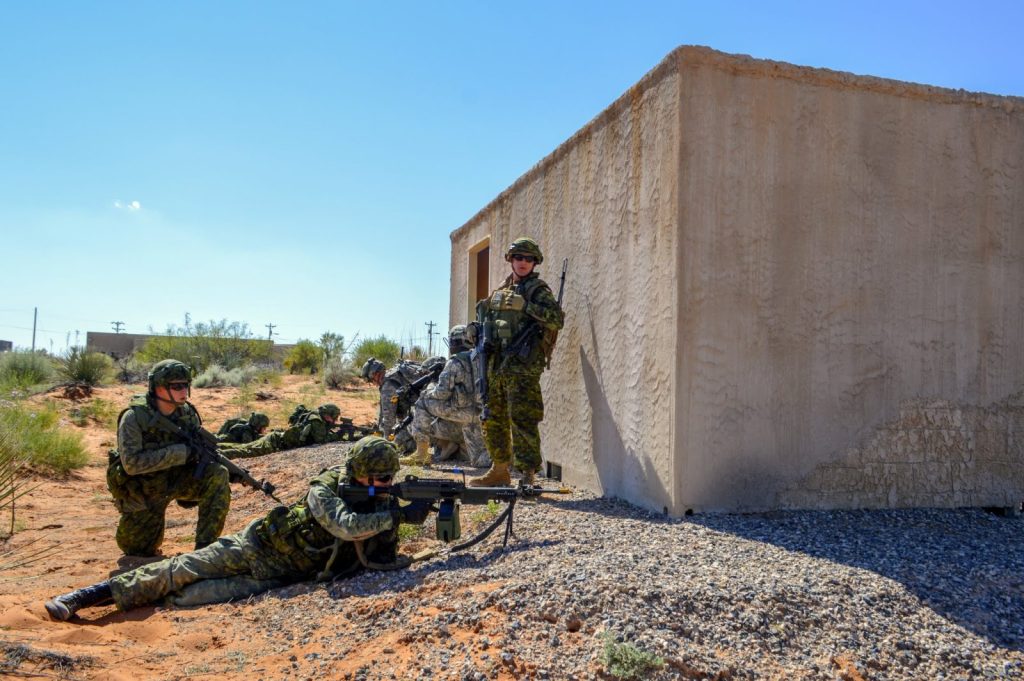by Maude Amyot-Bourgeois, Dr. George Nikolakakos, Dr. Katherine M. Banko
The Canadian Army, both alone and with allies, regularly conducts live and computer assisted exercises (CAX). Often incorporating military simulation and virtual components, these activities can be used to achieve a variety of goals including the identification of capability gaps; exposure to near-ready technologies to improve procurement; the trialing or experimenting of new equipment and associated tactics, techniques, and procedures (TTPs) (e.g., Bold Quest); exploring new organizational structures and/or concepts (e.g., Exercise Virtual Bear); and conducting large-scale training to meet force generation requirements (e.g., Maple Resolve and Unified Resolve).
Operations Research Scientists from the Centre for Operational Research and Analysis (CORA) have a long and successful history of providing rigorous analytical support to such events. Past efforts have included developing experimentation and data collection plans, providing assessments and recommendations to improve aspects such as TTPs or the simulation environment employed, and collecting and analyzing post-exercise data to help evaluate the effectiveness of the exercise and make recommendations for the next cycle.
This article highlights several activities that have been supported by the CORA Canadian Army Operational Research and Analysis Team (CA ORAT) in recent years.

During Bold Quest 15.2, approximately 40 Canadian, American, and Danish soldiers rehearsed a combat mission using virtual battle space simulation equipment. Photo: Courtesy CORA
Domestic Events
The on-going conflict between Ukraine and Russia has highlighted the vulnerability of traditional large, static, centralized command posts (CP) on the modern battlefield. To counter this vulnerability and enhance the survivability of future CPs against near-peer opponents, the Army recently developed and explored a new decentralized CP concept. Termed the expeditionary dispersed brigade CP, the concept involves operating with distributed and highly mobile CPs which function as communication nodes.
In November 2022, the 2 Canadian Mechanized Brigade Group (2CMBG) Headquarters and Signals Squadron explored the distributed CP concept during Exercise Virtual Bear. A secondary objective of the exercise involved partnering with industry to trial a new command and control (C2) software tool as part of the Army’s digital transformation efforts. The exercise participants were separated into different nodes, each with a specific operational function, and the nodes were geographically distributed across Canadian Forces Base Petawawa and Gagetown. Information from a simulated combat scenario was relayed to the nodes who each carried out their relevant tasks within the context of the new CP concept.
Over the course of the exercise, data was collected through observations, interviews with exercise leads, and discussions with exercise participants. Recommendations toward establishing future CP-related experimental approaches and data collection plans were provided.
The Army Intelligence Regiment is currently developing and executing a series of computer-assisted training exercises in collaboration with the Canadian Army Simulation Centre (CASC). The primary objective of this project is to develop and trial a customized synthetic training environment (STE) that will enable demanding and realistic intelligence training. To that end, the exercise leads requested analytical support from the CA ORAT to aid in investigating the simulation requirements for developing an optimally tailored STE. Exercise Rising Star, a section-sized intelligence training exercise conducted May 2023, served as a major first step in this initiative.
The STE applied during the exercise consisted of four separated Intelligence Support Teams (IST) that reported to a simulated command post headquarters. Each IST conducted intelligence tasks based on real-time feedback from a simulated battle played by interactors. The event was used as an opportunity to gain insight into the requirements for achieving an effective intelligence-focused STE and to assess the execution of the exercise. The assessment was based on pre- and post-exercise survey data from exercise participants, supplemented by interviews with participants during the event.
The study identified priority intelligence-focused simulation requirements (e.g., sensor, terrain, environmental effects) and examined potential limitations of the STE architecture and overall exercise execution.

After mission rehearsal on BQ 15.2, the soldiers executed the same mission in a tactical environment. Photo: Courtesy CORA
Multinational Events
Bold Quest (BQ) is a large-scale technical demonstration and experimentation event with participation from almost two dozen allied countries; the overall emphasis of BQ is interoperability. A series of three BQ events that benefited from operational research support are highlighted below.
For BQ15.2, the Canadian Army Land Warfare Centre (CALWC) undertook an assessment of military ethos and social (unit) and task (mission objective) cohesion within a dismounted infantry platoon. Using a combined training approach, approximately 40 Canadian, American, and Danish soldiers rehearsed a combat mission using virtual battlespace simulation equipment (VBS3). They then executed the same mission in a tactical environment using simulated munitions with actors playing the role of insurgents. Prior to the exercise, cultural differences between nations were evident regarding levels of trust, however, these effects disappeared over the progression of BQ15. Even when sections/squads were mixed with soldiers from different nations, it did not negatively impact ethos or cohesion measures.
In BQ 16.2, CALWC undertook an assessment of how the addition of a technological system (Net Warrior) into dismounted infantry teams impacted team performance, situational awareness, and operational effectiveness. Approximately 90 Canadian, New Zealand and American Army personnel from dismounted infantry sections participated as part of a regular tasking. The addition of the technology improved perceptions of performance and situational awareness. There was no evidence to suggest that it increased cognitive load to the point that it was not manageable.
Furthering the previous work on interoperability and the effects of technology on load and small team effectiveness, in BQ17.2 Canadian, New Zealand, American soldiers and Marines wore different battle management systems (BMS) while conducting a variety of day and night tactical missions. The ability of the Integrated Soldier System Suite (ISS-S) to integrate with other dismounted BMS to improve situational awareness and, as a result, increase operational effectiveness, was tested. For technical interoperability, data sharing required third-party service.
From a human dimension perspective, the company, platoon, and section performed as a cohesive, mission-focused unit. The BMS improved situational awareness and enhanced tactical performance.
Long term experimentation plans such as those applied to BQ can provide the greatest benefits as was demonstrated in the BQ series. Repetition and extension are the hallmarks of robust scientific work and with proper planning can be applied effectively to military settings.
Experiment Virtual Eagle, organized and run by the British Army and analysts from the U.K. Defence Science and Technology Laboratory (DSTL) with support from allied analysts, incorporated approximately 180 military personnel conducting high fidelity simulated battles in a networked environment. The experiment assessed the effectiveness of the future U.K. Funded Force (FF25) Armoured Infantry Battle Group against a representative peer threat. A secondary experimental goal was to evaluate the potential for employing a battle group level virtual laboratory based on VBS3.
The experiment enabled the British Army to explore new operating concepts and doctrine related to their future force. Insights from the event were further leveraged by the CA ORAT to develop a method that could be applied by the Canadian Army to conduct similar studies that combine existing virtual simulation training exercises with experimentation objectives.
Looking Ahead
In the present complex and resource-competitive environment, it is increasingly important that militaries leverage training exercises and warfighter experiments to extract valuable data and insights. Scientific support from CORA researchers can provide valuable analytics and experimentation tools and approaches during the planning, execution, and post-exercise analysis phases of these events. The authors encourage Army organizations to reach out to the team to explore potential opportunities for future collaboration (please email Maude Amyot-Bourgeois at maude.amyot-bourgeois@forces.gc.ca).




